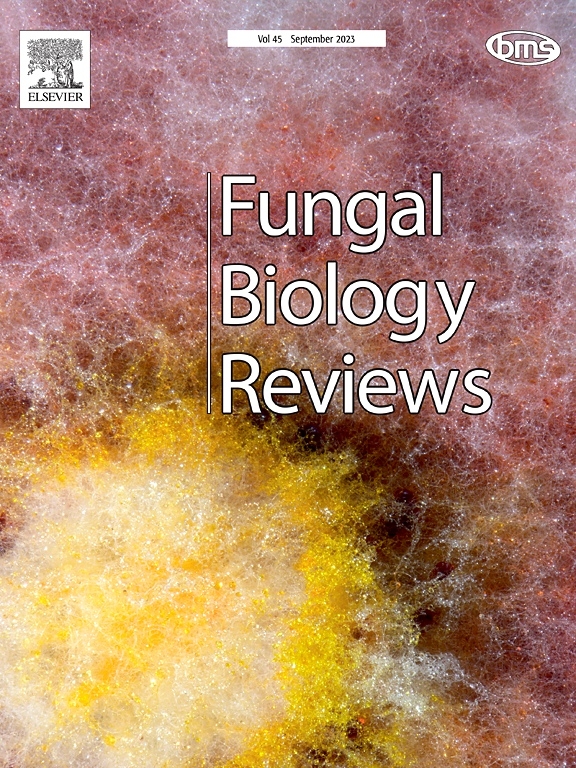地衣水化、水分动力学和气候变化:既有方法的综合和潜在的新方向
IF 4.6
2区 生物学
Q1 MYCOLOGY
引用次数: 0
摘要
使用功能性状方法通常在理解地衣如何分布,解释它们的发生和丰度方面取得了成功。事实上,这一成功突出了理解地衣物种内部和物种之间以及群落尺度上的性状变异的重要性,特别是在性状与水合动力学和随后的光合作用有关的地方。这篇综述总结了我们所知道的影响水合作用的地衣性状。我们展示了一些地衣属性——今天仍然是关注的焦点——在近一个世纪前就被描述了,并且经历了改进和重新开发。然而,仍然需要对性状测量进行明确的标准化,为了帮助组织这一进程,我们对核心性状和辅助性状进行了区分,核心性状的影响被很好地分类,对个体适合度和物种或群落反应的测量具有很强的预测性控制,而辅助性状则值得研究,但目前在功能性状研究中不太确定或不太清楚地推广或转移作用。此外,我们认为地衣不仅是多水的(被广泛引用),而且也是多热的(被较少引用),并且影响水合作用的性状与影响其热性能的性状(如菌体颜色)密切相关。菌体颜色很容易被量化为一种核心性状,并且可以应用于硬壳地衣,以便与疏水性一起,在地衣生长形式中更好地实现功能性状的可转移性,延伸到大地衣之外。未来的关键挑战包括在微生境尺度上实现地衣特征响应的规模化,以了解景观和生态系统尺度上的新兴效应,我们概述了新技术如何快速发展,以弥合这一差距。虽然不是详尽的,但综述提供了有针对性的背景文献,有助于地衣学家接近基于性状的生态学,或生态系统生态学家接近地衣。本文章由计算机程序翻译,如有差异,请以英文原文为准。

Lichen hydration, moisture dynamics and climate change: A synthesis of established methods and potential new directions
The use of a functional trait approach has generally shown success in understanding how lichens are distributed, explaining their occurrence and abundance. Indeed, this success highlights the importance of understanding trait variability within and among lichen species, and at a community scale, especially where traits are related to hydration dynamics and subsequent photosynthetic activity. This review summarises what we know about lichen traits affecting hydration. We show that some lichen attributes – still the focus of attention today – were being described nearly a century ago and have since undergone refinement and redevelopment. Yet there remains a need for clear standardisation of trait measurements, and to help organise this progress we offer a distinction between core traits – whose effects are well categorised, and which have strong predictive control over measures of individual fitness and species or community response – and ancillary traits – that are worthy of investigation, but that currently have a less certain or a less clearly generalisable or transferable role in functional trait studies. Furthermore, we argue for recognition that lichens are not only poikilohydric (well cited) but also poikilothermic (less well cited), and that traits affecting hydration are closely coupled to traits (such as thallus colour) affecting their thermal properties. Thallus colour is easily quantified as a core trait and can be applied to crustose lichens so that – along with hydrophobicity – the transferability of functional traits is better achieved across lichen growth-forms, extending beyond macrolichens. Key future challenges include the scaling of lichen trait responses realised at microhabitat scales, to understand emergent effects at landscape and ecosystem scales, and we outline how new technologies are rapidly developing, to bridge this gap. Although not exhaustive, the review offers a precis of targeted background literature, helpful to lichenologists approaching trait-based ecology, or ecosystem ecologists approaching lichens.
求助全文
通过发布文献求助,成功后即可免费获取论文全文。
去求助
来源期刊

Fungal Biology Reviews
MYCOLOGY-
CiteScore
10.60
自引率
0.00%
发文量
36
期刊介绍:
Fungal Biology Reviews is an international reviews journal, owned by the British Mycological Society. Its objective is to provide a forum for high quality review articles within fungal biology. It covers all fields of fungal biology, whether fundamental or applied, including fungal diversity, ecology, evolution, physiology and ecophysiology, biochemistry, genetics and molecular biology, cell biology, interactions (symbiosis, pathogenesis etc), environmental aspects, biotechnology and taxonomy. It considers aspects of all organisms historically or recently recognized as fungi, including lichen-fungi, microsporidia, oomycetes, slime moulds, stramenopiles, and yeasts.
 求助内容:
求助内容: 应助结果提醒方式:
应助结果提醒方式:


